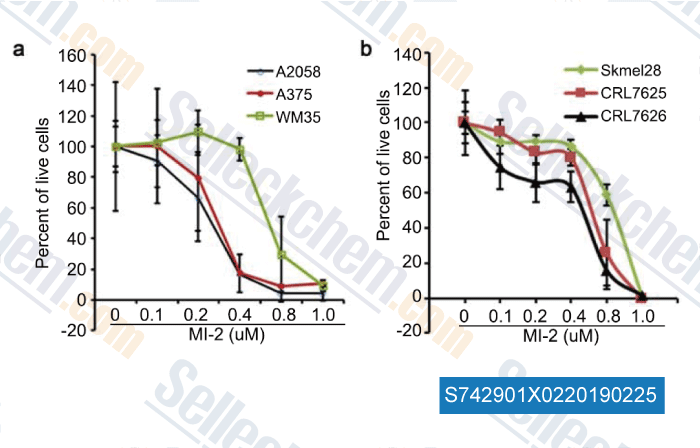|
Toll Free: (877) 796-6397 -- USA and Canada only -- |
Fax: +1-832-582-8590 Orders: +1-832-582-8158 |
Tech Support: +1-832-582-8158 Ext:3 Please provide your Order Number in the email. |
Technical Data
| Formula | C19H17Cl3N4O3 |
||||||
| Molecular Weight | 455.72 | CAS No. | 1047953-91-2 | ||||
| Solubility (25°C)* | In vitro | DMSO | 91 mg/mL (199.68 mM) | ||||
| Ethanol | 21 mg/mL (46.08 mM) | ||||||
| Water | Insoluble | ||||||
| In vivo (Add solvents to the product individually and in order) |
|
||||||
|
* <1 mg/ml means slightly soluble or insoluble. * Please note that Selleck tests the solubility of all compounds in-house, and the actual solubility may differ slightly from published values. This is normal and is due to slight batch-to-batch variations. * Room temperature shipping (Stability testing shows this product can be shipped without any cooling measures.) |
|||||||
Preparing Stock Solutions
Biological Activity
| Description | MI-2 (MALT1 inhibitor) is an irreversible MALT1 inhibitor with IC50 of 5.84 μM. | ||
|---|---|---|---|
| Targets |
|
||
| In vitro | MI-2 (MALT1 inhibitor) inhibits MALT1 functions in ABC-DLBCL cell lines with excellent cell penetration. It produces selective growth inhibition for MALT1-dependent cell lines with GI50 of 0.2, 0.5, 0.4, and 0.4 礛 in HBL-1, TMD8, OCI-Ly3, and OCI-Ly10 cells, whereas the ABC-DLBCL MALT1-independent cell lines, U2932 and HLY-1, and the two GCB-DLBCL cell lines were resistant. [1] | ||
| In vivo | MI-2 (MALT1 inhibitor) is nontoxic to mice at 350 mg/kg. This compound (25 mg/kg/day i.p.) profoundly suppresses the growth of both the TMD8 and HBL-1 ABC-DLBCL xenografts, whereas it has no effect on the growth of OCI-Ly1 tumors. [1] |
Protocol (from reference)
| Kinase Assay:[1] |
|
|---|---|
| Cell Assay:[1] |
|
| Animal Study:[1] |
|
References
|
Customer Product Validation

-
Data from [ , , Oncogenesis, 2017, 6(7):e365 ]
Selleck's MI-2 (MALT1 inhibitor) Has Been Cited by 15 Publications
| Hepatitis B Virus-KMT2B Integration Drives Hepatic Oncogenic Processes in a Human Gene-edited Induced Pluripotent Stem Cells-derived Model [ Cell Mol Gastroenterol Hepatol, 2025, 19(2):101422] | PubMed: 39419394 |
| T Cells Spatially Regulate B Cell Receptor Signaling in Lymphomas through H3K9me3 Modifications [ Adv Healthc Mater, 2024, e2401192.] | PubMed: 38837879 |
| Cotargeting of BTK and MALT1 overcomes resistance to BTK inhibitors in mantle cell lymphoma [ J Clin Invest, 2023, 133(3)e165694] | PubMed: 36719376 |
| Proteolytic Activity of the Paracaspase MALT1 Is Involved in Epithelial Restitution and Mucosal Healing [ Int J Mol Sci, 2023, 24(8)7402] | PubMed: 37108564 |
| Proteolytic Activity of the Paracaspase MALT1 Is Involved in Epithelial Restitution and Mucosal Healing [ Int J Mol Sci, 2023, 24(8)7402] | PubMed: 37108564 |
| Inhibition of Histone H3 Lysine-27 Demethylase Activity Relieves Rheumatoid Arthritis Symptoms via Repression of IL6 Transcription in Macrophages [ Front Immunol, 2022, 13:781364] | PubMed: 35296093 |
| MLL1 inhibition reduces IgM levels in Waldenström macroglobulinemia [ Leuk Res, 2022, 116:106841] | PubMed: 35462170 |
| Extrinsic interactions in the microenvironment in vivo activate an antiapoptotic multidrug-resistant phenotype in CLL [ Blood Adv, 2021, 5(17):3497-3510] | PubMed: 34432864 |
| Inhibition of MALT1 Alleviates Spinal Ischemia/Reperfusion Injury-Induced Neuroinflammation by Modulating Glial Endoplasmic Reticulum Stress in Rats [ J Inflamm Res, 2021, 14:4329-4345] | PubMed: 34511971 |
| Copanlisib synergizes with conventional and targeted agents including venetoclax in B- and T-cell lymphoma models. [ Blood Adv, 2020, 4(5):819-829] | PubMed: 32126142 |
RETURN POLICY
Selleck Chemical’s Unconditional Return Policy ensures a smooth online shopping experience for our customers. If you are in any way unsatisfied with your purchase, you may return any item(s) within 7 days of receiving it. In the event of product quality issues, either protocol related or product related problems, you may return any item(s) within 365 days from the original purchase date. Please follow the instructions below when returning products.
SHIPPING AND STORAGE
Selleck products are transported at room temperature. If you receive the product at room temperature, please rest assured, the Selleck Quality Inspection Department has conducted experiments to verify that the normal temperature placement of one month will not affect the biological activity of powder products. After collecting, please store the product according to the requirements described in the datasheet. Most Selleck products are stable under the recommended conditions.
NOT FOR HUMAN, VETERINARY DIAGNOSTIC OR THERAPEUTIC USE.
